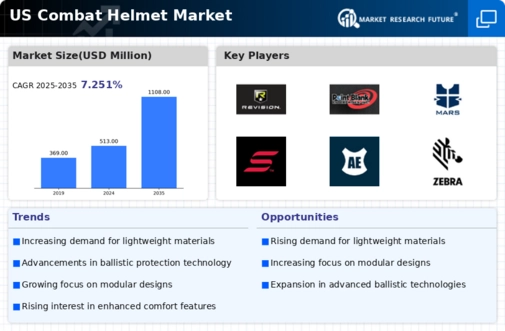The US Combat Helmet Market is characterized by a competitive landscape that includes both established companies and newer entrants vying for market share. As military forces increasingly prioritize soldier safety and operational efficiency, the need for advanced combat helmets has become paramount. The market is driven by innovations in materials, design, and technology, as manufacturers seek to enhance ballistic protection, comfort, and additional features such as communication systems and modular designs.
The competitive environment is influenced by government contracts, technological advancements, and evolving defense requirements, which necessitate manufacturers to stay ahead of trends while responding to the changing needs of armed forces. With a growing emphasis on lightweight materials and versatile helmets that support various missions, companies in this sector are continuously improving their product lines to maintain competitiveness and ensure that military personnel are adequately protected.Revision Military has made significant strides within the US Combat Helmet Market, focusing on providing high-performance ballistic helmets and head protection systems specifically designed for military use.
The company's strengths lie in its commitment to innovation and the use of cutting-edge materials, which have positioned its products as some of the most sought after in the market. Revision Military has a strong presence in the US, leveraging partnerships with various branches of the armed forces to supply helmets tailored to specific operational requirements. Their focus on rigorous testing and compliance with military standards ensures that their products not only meet but often exceed expectations for safety and performance.
This dedication to quality and functionality has earned Revision Military a solid reputation among defense contractors and military end-users alike.Honeywell International is another key player in the US Combat Helmet Market, known for its comprehensive range of advanced protective equipment, including helmets that provide superior ballistic performance and occupant safety. The company’s product offerings include not only combat helmets but also integrated systems that enhance soldier survivability and operational effectiveness. Honeywell's strengths stem from its extensive research and development capabilities, which enable the creation of innovative materials and designs that cater to modern defense needs.
The company maintains a noteworthy market presence in the US due to its successful collaborations and partnerships with military agencies. Additionally, Honeywell has engaged in strategic mergers and acquisitions that have bolstered its product portfolio, allowing for a broader scope of offerings in the combat helmet arena. These initiatives reflect Honeywell's commitment to enhancing the safety and performance of military personnel while securing a competitive edge within the market.


















